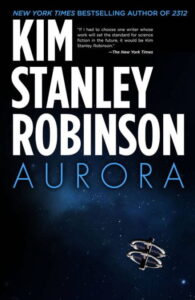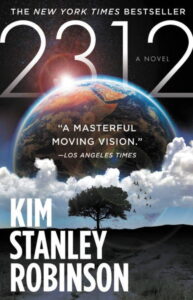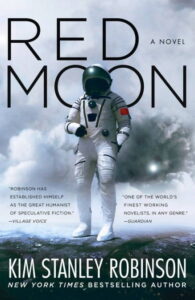There’s No Sheriff on This Planet: A Conversation with Kim Stanley Robinson

Acclaimed science fiction author Kim Stanley Robinson visited Madison, Wisconsin, on Monday, April 22 to deliver a keynote address at the 2019 Nelson Institute Earth Day Conference. During his visit, we spoke about ecological consciousness in the Anthropocene, the rise of neofascism, and planetary engineering. We also discussed the environmentalist and utopian themes in Robinson’s recent fiction, especially his classic alternate history story about Hiroshima, “The Lucky Strike” (1984) and his brilliant and provocative deep-space-colonization novel Aurora (2015).
Building on conversations we began while co-editing Green Planets: Ecology and Science Fiction (2014), we explored the hope science fiction can still offer for the future in this dark time.
Stream or download our conversation here. Interview highlights, edited for clarity, follow.
Podcast: Play in new window | Download
Subscribe: Spotify | TuneIn | RSS
Interview highlights:
This transcript has been edited for length and clarity.
GC: I taught an environmental literatures class this semester and taught quite a bit of your work. One of the things we looked at was your piece on the left’s case for geoengineering, and the need to think about geoengineering as being part of the left’s agenda. Do you mind talking a little bit about that?
KSR: There’s a common knee-jerk reaction on the left—and I am a leftist—at the very notion of geoengineering as being hubristic, a technological silver bullet, and as allowing capitalism to go on the way it’s going on and yet getting away with it. So, geoengineering has a lot of bad associations as a word and as a concept. But we are headed for some environmental disasters with climate change—the sixth great mass extinction event—and we’re not doing a good job of reducing our fossil fuel burn (the CO2 burn into the atmosphere), despite our good intentions and even the great Paris Accords. We still aren’t making progress fast enough in slowing down the burn. At a certain point, some of these geoengineering notions are going to be, perhaps, the only way to keep us from dropping into a mass extinction event. So, this is the science fictional scenario. What if it gets bad enough that we need to try them? What would they do? Are they real or are they just fantasies? Could they work if we tried them? That’s the kind of investigation that I’m thinking about.
GC: But it sounds like you do believe at least some would have the capacity for efficacy on the right timetable and with the right developments.
KSR: Maybe. The most well-known is a solar radiation management, as it’s sometimes called. It essentially imitates a Pinatubo-style volcanic eruption, throwing dust into the atmosphere and thereby deflecting some sunlight and depressing world temperatures for about five years, after which the dust settles back to the ground. We’ve seen that happen with Pinatubo and other volcanic eruptions, and we probably can imitate one. This, naturally, makes people intensely nervous. There’s a knee-jerk reaction, which is to say “well, that’s for sure going to go wrong.” And you get movies like Snowpiercer, where we accidentally create an ice age.

Some advocates of geoengineering have proposed a form of solar radiation management modeled on the 1991 Mount Pinatubo volcanic eruption, seen here. Photo by Dave Harlow, 1991.
But that can’t happen. If you look at it as another volcanic eruption—but one that we created—you can see that it might be run as an experiment, where for five years we got lower temperatures. It’s easy and true to say that solves nothing, because it doesn’t deal with ocean acidification. It doesn’t decarbonize. It merely deflects sunlight. But there may be people on this planet in 20 to 30 years who live in hotter places than us, for whom these niceties of “there are some things man is not meant to try” coming from the prosperous leftist West, the ones that have burned the most carbons, may not be convincing. There may be nation states on this planet that say, “well, we don’t care about that because we’re dying of heat.” So, I’m interested in that one as something that is likely to happen.
With words like geoengineering, it’s a matter of reification. We reify these words. They were ideas. They were fluid, and then we reify them into a thing that you can then oppose, like fascism or something that is automatically and without having to think about it much, bad. I’m going to argue that we better un-reify and re-liquidify these ideas and think about them more openly.
GC: A lot of my students really wanted to rebrand geoengineering, as geodesign or geoprecision or some other word that didn’t sound quite so scary but also acknowledged the ambiguities of it. Engineering sounds like you know exactly what you’re getting into.
KSR: My wife’s a scientist and points out that engineers really never know all the factors involved when, for example, they build a bridge. They just work within the constraints of their ignorance. And yet, we think of engineering as something in which we know what we’re doing and we build the bridges. So, geotweaking, geofinessing, or geobegging where we beg Gaia to do the thing that we are praying to it to do with these tiny little gestures.
Because, in many ways, the things that we can do are minuscule on the scale of planetary energy flows. We can’t deacidify the ocean, for instance. There are things that we flat out don’t have the power to do. So, when you look at the few little things that we can possibly do, first you have to look for the fantasy element in them that would make them impossible if we were to really try them. And then, if there seems to be a viable plan there, then you have to keep it on the table as an emergency option.

Kim Stanley Robinson (R) speaks with Gerry Canavan at the Nelson Institute Earth Day Conference. Photo by Brian Hamilton, 2019.
GC: What you said about places, like India, where the predictions for livable temperatures are fairly dire seems to bring up two interrelated problems. First, that there’s no kind of global government that can make these decisions in a rational way. And second, that so many of the liberal democracies that we might hope would make the decisions seem to be retrenching into rightwing or even neofascist movements. We’ve been talking about this a long time, so I’m curious what gives you hope politically today in this moment when we seem to be drifting towards a kind of climate fascism.
KSR: The thing that I gives me hope is the Paris Accords. When we first began this discussion maybe fifteen years ago, that would have been a completely utopian prospect. If I’d said, well, what we need is an international organization that’s under the U.N. auspices, where all the nations come to agree to their own carbon burn reduction and that would be a framework going forward—if I’d proposed that—it would have been a Robinsonian utopian science fiction idea. And yet it happened in the real world.
Fifteen years ago, the Paris Accords would have been a Robinsonian utopian science fiction idea. And yet it happened in the real world.
Of course, it’s not enough. It’s endangered. It’s just a set of promises, and there is no sheriff. There’s no sheriff on this planet to make us do the right thing. So, then you have to think, well, is there a growing sense of the global village, that we’re really all one civilization on one planet where everything connects to everything else? And I think that awareness is there. I get hope by the fact that there are as many cell phones or more cell phones than there are people, that there are almost as many smartphones as there are people. And that even the people who are illiterate can be also at the same time fully informed because of their smartphones and because of their social connections and because of what we used to call word of mouth.
The global village is a real thing now. And that’s one of the good effects of the Internet, which has got some bad effects, too, and some questionable effects. There’s no doubt about it that the sense of global awareness—that we’re all on one planet and that whatever is happening to the poorest person on the planet is also happening to you—might be a driver to good action.
GC: There’s a strain that runs through a lot of your work of primitivists, often men, with intense interest in the primitive, the evolutionary environment to which we are suited, as well as this urban context in which we live now. In that class I was talking about earlier, we read both the introduction of Future Primitive and your recent op-ed in The Guardian about everybody moving into cities. I am curious about that divide and thinking about ourselves as bodies more than as minds. Science fiction hasn’t always done that. The great science fiction dream is just to get rid of the body altogether, right.
KSR: Right. These were urban men who mostly wrote the Golden Age science fiction, and so they were expressing their own sense of themselves. Asimov, very much an agoraphobic person, set the Golden Age rubric. You’ve identified a contradiction in my work and in humanity at large. On the one hand, we did evolve to be outdoors, in our bodies, wandering around outdoors every day, doing the paleolithic activities, and when we do them now, we’re happy. On the other hand, there’s seven and a half billion of us, soon to be eight billion, and the planet is maybe not providing enough as a biosphere to support all those people living the full outdoor life. Although the outdoor life has a much lower carbon burn, so who knows.
There’s no sheriff on this planet to make us do the right thing. But a sense of global awareness—that we’re all on one planet—might be a driver to good action.
What do you do? It’s a problem, a contradiction that can’t be solved. We’re social primates, we’re evolved to be outdoors doing those things and to the extent that we sit in boxes and look at other screens on little boxes, we are unhealthy and going nuts. We’re a neurotic culture made of neurotic individuals. But we still need to be urban. It’s better for the biosphere, for the planet, for the other animals, if we were to collect in urban collectivities. The worst, probably, is suburbia, for land use, nuclear family, isolation. For many other reasons, we’re better off in cities than we are in suburbs.
But then what do you do about being a social primate? Well, there’s something in the technological sublime, that when you’re where you can see five hundred other humans, you’re naturally elevated and excited. It’s a rush. Cities are a rush. They’re sublime experiences, both beautiful and terrifying. So, I guess I would say I am currently trying to reconcile those two views, that we need both. To be happy individually and sane socially, we need to acknowledge that we’re animals amongst the rest of the animals. And yet for the biosphere, we need to find animal pleasures in the cities, so it makes sense that there are dance clubs, swim clubs, riverside walks, and rooftop gardens. The urban is a space that still has an outdoors.

As homes replaced herds in Southern California, a young Robinson turned to science fiction to understand these startling changes. Photo by Charles O’Rear, 1975.
GC: What’s the most important lesson science fiction has for us today? Or does it have lessons?
KSR: Oh, I think it does. It’s a good question. I’m a real patriot of the genre. I made an instinctive choice of it. It felt right to me when I was 20 years old in 1970 or so. I discovered science fiction and I thought, this is right, this is the literature that speaks to me. And I think now it’s becoming more the case that it speaks to everybody. What happened to me was, I grew up in Southern California. It was agricultural. The agriculture got ripped out. It became a city right in front of my eyes. Science fiction described that in a way that ordinary literature didn’t. Now everybody’s getting that feeling.
So, when you go to science fiction, you get crazy adventures, you get a lot of hidden fantasies, no doubt about it. But you also get modeled futures. If we do A we get to B, if we do X we get to Y. There are always if-then statements. It’s very much a historical literature. It’s historical fiction, but cast into fictional futures. It gives that feeling that you want literature to give people, the religious fervor, in that it makes things matter and it gives meaning to your individual existence by orienting you in history. Science fiction is very, very good at that right now. Not always, and not across the entirety of the big genre. Some of them are more useful in terms of modeling exercises than others, but they’re always fun. So, yeah, science fiction. God bless it.
Featured image: Kim Stanley Robinson (photo by Gage Skidmore, 2017) is pictured here against the backdrop of the Earth’s eastern hemisphere (image via NASA, 2011).
Podcast music: “Gloves” by Julian Lynch. Used with permission.
Kim Stanley Robinson is an American science fiction writer. He is the author of more than 20 books, including the international bestselling Mars trilogy and, more recently, Red Moon, New York 2140, and 2312, which was a New York Times bestseller nominated for all seven of the major science fiction awards—a first for any book. Among his many longstanding efforts to address and understand environmental change, Robinson was part of the U.S. National Science Foundation’s Antarctic Artists and Writers program. In 2008 he was named one of Time magazine’s “Heroes of the Environment” and in 2016, asteroid 72432 was named “Kimrobinson.” Contact.
Gerry Canavan is an associate professor in the English Department at Marquette University, specializing in twentieth- and twenty-first-century literature. He co-edited Green Planets: Ecology and Science Fiction (2014) with Kim Stanley Robinson. An editor at Extrapolation and Science Fiction Film and Television, he has also co-edited The Cambridge Companion to American Science Fiction (2015) and The Cambridge History of Science Fiction (2019). His first monograph, Octavia E. Butler, appeared in 2016 in the Modern Masters of Science Fiction series at University of Illinois Press. Website. Twitter. Contact.




You must be logged in to post a comment.